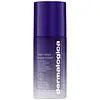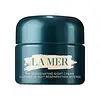What's inside
What's inside
 Key Ingredients
Key Ingredients

 Benefits
Benefits

 Concerns
Concerns

 Ingredients Side-by-side
Ingredients Side-by-side

Water
Skin ConditioningSimmondsia Chinensis Seed Oil
EmollientGlycerin
HumectantNeopentyl Glycol Diheptanoate
EmollientSqualane
EmollientHydrogenated Ethylhexyl Olivate
EmollientPropanediol
SolventCaprylic/Capric Triglyceride
MaskingPentylene Glycol
Skin ConditioningCamellia Japonica Seed Oil
EmollientButylene Glycol
HumectantC12-15 Alkyl Benzoate
AntimicrobialSodium Hyaluronate
HumectantUbiquinone
AntioxidantGlycine Soja Oil
EmollientPEG-40 Hydrogenated Castor Oil
EmulsifyingHelianthus Annuus Seed Oil
EmollientCitrus Aurantium Bergamia Fruit Oil
MaskingCitrus Limon Peel Oil
MaskingRosmarinus Officinalis Leaf Extract
AntimicrobialViola Odorata Leaf Extract
MaskingCarthamus Tinctorius Seed Oil
MaskingTropaeolum Majus Flower/Leaf/Stem Extract
Skin ConditioningAstragalus Membranaceus Root Extract
EmollientSpilanthes Acmella Flower/Leaf/Stem Extract
AntimicrobialLavandula Spica Flower/Leaf/Stem Extract
Skin ConditioningLigustrum Lucidum Seed Extract
Skin ConditioningCitrus Aurantium Dulcis Oil
MaskingRosmarinus Officinalis Flower/Leaf/Stem Extract
MaskingSalvia Sclarea Extract
AntiseborrhoeicLitsea Cubeba Fruit Oil
MaskingMentha Piperita Flower/Leaf/Stem Extract
MaskingLuffa Cylindrica Root Extract
Skin ConditioningHydrogenated Olive Oil Unsaponifiables
EmollientTocopherol
AntioxidantPhospholipids
Skin ConditioningGlycogen
HumectantCaprylyl Glycol
EmollientGlycolipids
Skin ConditioningAcrylates/C10-30 Alkyl Acrylate Crosspolymer
Emulsion StabilisingGlycine Soja Sterols
EmollientDicaprylyl Ether
EmollientXanthan Gum
EmulsifyingC15-19 Alkane
SolventEthylhexylglycerin
Skin ConditioningPolysorbate 20
EmulsifyingTetrasodium Glutamate Diacetate
Phytic Acid
Lauryl Glucoside
CleansingSodium Hydroxide
BufferingSodium Acrylate/Sodium Acryloyldimethyl Taurate Copolymer
Emulsion StabilisingSodium Benzoate
MaskingWater, Simmondsia Chinensis Seed Oil, Glycerin, Neopentyl Glycol Diheptanoate, Squalane, Hydrogenated Ethylhexyl Olivate, Propanediol, Caprylic/Capric Triglyceride, Pentylene Glycol, Camellia Japonica Seed Oil, Butylene Glycol, C12-15 Alkyl Benzoate, Sodium Hyaluronate, Ubiquinone, Glycine Soja Oil, PEG-40 Hydrogenated Castor Oil, Helianthus Annuus Seed Oil, Citrus Aurantium Bergamia Fruit Oil, Citrus Limon Peel Oil, Rosmarinus Officinalis Leaf Extract, Viola Odorata Leaf Extract, Carthamus Tinctorius Seed Oil, Tropaeolum Majus Flower/Leaf/Stem Extract, Astragalus Membranaceus Root Extract, Spilanthes Acmella Flower/Leaf/Stem Extract, Lavandula Spica Flower/Leaf/Stem Extract, Ligustrum Lucidum Seed Extract, Citrus Aurantium Dulcis Oil, Rosmarinus Officinalis Flower/Leaf/Stem Extract, Salvia Sclarea Extract, Litsea Cubeba Fruit Oil, Mentha Piperita Flower/Leaf/Stem Extract, Luffa Cylindrica Root Extract, Hydrogenated Olive Oil Unsaponifiables, Tocopherol, Phospholipids, Glycogen, Caprylyl Glycol, Glycolipids, Acrylates/C10-30 Alkyl Acrylate Crosspolymer, Glycine Soja Sterols, Dicaprylyl Ether, Xanthan Gum, C15-19 Alkane, Ethylhexylglycerin, Polysorbate 20, Tetrasodium Glutamate Diacetate, Phytic Acid, Lauryl Glucoside, Sodium Hydroxide, Sodium Acrylate/Sodium Acryloyldimethyl Taurate Copolymer, Sodium Benzoate
Water
Skin ConditioningAlgae Extract
EmollientButyrospermum Parkii Butter
Skin ConditioningDimethicone
EmollientButylene Glycol
HumectantCaprylic/Capric/Myristic/Stearic Triglyceride
EmollientPolyglyceryl-3 Methylglucose Distearate
EmulsifyingGlycerin
HumectantSilica
AbrasiveCoco-Caprylate/Caprate
EmollientSimmondsia Chinensis Seed Oil
EmollientMangifera Indica Seed Butter
Skin ConditioningPolyglyceryl-10 Pentastearate
Skin ConditioningGlyceryl Stearate
EmollientBehenyl Alcohol
EmollientPEG-100 Stearate
Dimethicone/Vinyl Dimethicone Crosspolymer
Skin ConditioningSesamum Indicum Seed Oil
EmollientMedicago Sativa Seed Powder
Skin ConditioningHelianthus Annuus Seedcake
AbrasivePrunus Amygdalus Dulcis Seed Meal
AbrasiveEucalyptus Globulus Leaf Oil
PerfumingSodium Gluconate
Skin ConditioningCopper Gluconate
Skin ConditioningCalcium Gluconate
HumectantMagnesium Gluconate
Skin ConditioningZinc Gluconate
Skin ConditioningTocopheryl Succinate
AntioxidantNiacin
SmoothingSesamum Indicum Seed Powder
Skin ConditioningPalmitoyl Tripeptide-1
Skin ConditioningPalmitoyl Tetrapeptide-7
Skin ConditioningPalmitoyl Hexapeptide-12
Skin ConditioningAcetyl Hexapeptide-8
HumectantSodium Hyaluronate
HumectantCrithmum Maritimum Extract
Skin ConditioningLaminaria Digitata Extract
Skin ProtectingYeast Extract
Skin ConditioningCrithmum Maritimum Callus Culture Filtrate
Skin ProtectingBambusa Vulgaris Extract
Skin ConditioningCitrus Aurantifolia Peel Extract
CleansingCoffea Arabica Seed Extract
MaskingPisum Sativum Extract
Skin ConditioningMagnesium Ascorbyl Phosphate
AntioxidantCaffeine
Skin ConditioningTocopherol
AntioxidantTocopheryl Acetate
AntioxidantLecithin
EmollientCaprylic/Capric Triglyceride
MaskingEthylhexylglycerin
Skin ConditioningPotassium Cetyl Phosphate
EmulsifyingHydroxyethyl Acrylate/Sodium Acryloyldimethyl Taurate Copolymer
Emulsion StabilisingPEG-8
HumectantAcrylates/C10-30 Alkyl Acrylate Crosspolymer
Emulsion StabilisingSodium Stearoyl Lactylate
EmulsifyingGlyceryl Polymethacrylate
Carbomer
Emulsion StabilisingSodium Hydroxide
BufferingPolysorbate 60
EmulsifyingGlucosamine Hcl
Sorbitan Isostearate
EmulsifyingPolysorbate 20
EmulsifyingHydrogenated Vegetable Oil
EmollientCaprylyl Glycol
EmollientHexylene Glycol
EmulsifyingAlcohol Denat.
AntimicrobialParfum
MaskingLimonene
PerfumingLinalool
PerfumingHydroxycitronellal
PerfumingCitronellol
PerfumingGeraniol
PerfumingBenzyl Salicylate
PerfumingBenzyl Benzoate
AntimicrobialBHT
AntioxidantDisodium EDTA
Phenoxyethanol
PreservativeChlorphenesin
AntimicrobialPotassium Sorbate
PreservativeCI 15985
Cosmetic ColorantWater, Algae Extract, Butyrospermum Parkii Butter, Dimethicone, Butylene Glycol, Caprylic/Capric/Myristic/Stearic Triglyceride, Polyglyceryl-3 Methylglucose Distearate, Glycerin, Silica, Coco-Caprylate/Caprate, Simmondsia Chinensis Seed Oil, Mangifera Indica Seed Butter, Polyglyceryl-10 Pentastearate, Glyceryl Stearate, Behenyl Alcohol, PEG-100 Stearate, Dimethicone/Vinyl Dimethicone Crosspolymer, Sesamum Indicum Seed Oil, Medicago Sativa Seed Powder, Helianthus Annuus Seedcake, Prunus Amygdalus Dulcis Seed Meal, Eucalyptus Globulus Leaf Oil, Sodium Gluconate, Copper Gluconate, Calcium Gluconate, Magnesium Gluconate, Zinc Gluconate, Tocopheryl Succinate, Niacin, Sesamum Indicum Seed Powder, Palmitoyl Tripeptide-1, Palmitoyl Tetrapeptide-7, Palmitoyl Hexapeptide-12, Acetyl Hexapeptide-8, Sodium Hyaluronate, Crithmum Maritimum Extract, Laminaria Digitata Extract, Yeast Extract, Crithmum Maritimum Callus Culture Filtrate, Bambusa Vulgaris Extract, Citrus Aurantifolia Peel Extract, Coffea Arabica Seed Extract, Pisum Sativum Extract, Magnesium Ascorbyl Phosphate, Caffeine, Tocopherol, Tocopheryl Acetate, Lecithin, Caprylic/Capric Triglyceride, Ethylhexylglycerin, Potassium Cetyl Phosphate, Hydroxyethyl Acrylate/Sodium Acryloyldimethyl Taurate Copolymer, PEG-8, Acrylates/C10-30 Alkyl Acrylate Crosspolymer, Sodium Stearoyl Lactylate, Glyceryl Polymethacrylate, Carbomer, Sodium Hydroxide, Polysorbate 60, Glucosamine Hcl, Sorbitan Isostearate, Polysorbate 20, Hydrogenated Vegetable Oil, Caprylyl Glycol, Hexylene Glycol, Alcohol Denat., Parfum, Limonene, Linalool, Hydroxycitronellal, Citronellol, Geraniol, Benzyl Salicylate, Benzyl Benzoate, BHT, Disodium EDTA, Phenoxyethanol, Chlorphenesin, Potassium Sorbate, CI 15985
 Reviews
Reviews

Ingredients Explained
These ingredients are found in both products.
Ingredients higher up in an ingredient list are typically present in a larger amount.
Acrylates/C10-30 Alkyl Acrylate Crosspolymer is a synthetic polymer. It is used to thicken and improve the texture of products. Due to its properties, it can prevent water and oil ingredients from separating.
Butylene Glycol (or BG) is used within cosmetic products for a few different reasons:
Overall, Butylene Glycol is a safe and well-rounded ingredient that works well with other ingredients.
Though this ingredient works well with most skin types, some people with sensitive skin may experience a reaction such as allergic rashes, closed comedones, or itchiness.
Learn more about Butylene GlycolThis ingredient is an emollient, solvent, and texture enhancer. It is considered a skin-softener by helping the skin prevent moisture loss.
It helps thicken a product's formula and makes it easier to spread by dissolving clumping compounds.
Caprylic Triglyceride is made by combining glycerin with coconut oil, forming a clear liquid.
While there is an assumption Caprylic Triglyceride can clog pores due to it being derived from coconut oil, there is no research supporting this.
Learn more about Caprylic/Capric TriglycerideCaprylyl Glycol is a humectant and emollient, meaning it attracts and preserves moisture.
It is a common ingredient in many products, especially those designed to hydrate skin. The primary benefits are retaining moisture, skin softening, and promoting a healthy skin barrier.
Though Caprylyl Glycol is an alcohol derived from fatty acids, it is not the kind that can dry out skin.
This ingredient is also used as a preservative to extend the life of products. It has slight antimicrobial properties.
Learn more about Caprylyl GlycolEthylhexylglycerin (we can't pronounce this either) is commonly used as a preservative and skin softener. It is derived from glyceryl.
You might see Ethylhexylglycerin often paired with other preservatives such as phenoxyethanol. Ethylhexylglycerin has been found to increase the effectiveness of these other preservatives.
Glycerin is already naturally found in your skin. It helps moisturize and protect your skin.
A study from 2016 found glycerin to be more effective as a humectant than AHAs and hyaluronic acid.
As a humectant, it helps the skin stay hydrated by pulling moisture to your skin. The low molecular weight of glycerin allows it to pull moisture into the deeper layers of your skin.
Hydrated skin improves your skin barrier; Your skin barrier helps protect against irritants and bacteria.
Glycerin has also been found to have antimicrobial and antiviral properties. Due to these properties, glycerin is often used in wound and burn treatments.
In cosmetics, glycerin is usually derived from plants such as soybean or palm. However, it can also be sourced from animals, such as tallow or animal fat.
This ingredient is organic, colorless, odorless, and non-toxic.
Glycerin is the name for this ingredient in American English. British English uses Glycerol/Glycerine.
Learn more about GlycerinPolysorbate 20 is made by combining ethoxylation of sorbitan, ethylene oxide, and lauric acid. It is a mild cleansing agent, surfactant, and emulsifier.
As a surfactant, it helps collect dirt and oils for washing. Emulsifiers prevent oils and water from separating.
Polysorbate 20 also adds scent to a product. Since it is made using sorbitol, it has a sweet scent. Sorbitol can also be found in fruits such as apples and peaches.
The lauric acid used to create Polysorbate 20 is often derived from coconuts.
Polysorbate 20 may not be fungal acne safe.
Learn more about Polysorbate 20This oil comes from the seeds of the desert shrub called Jojoba. It is more commonly known as jojoba oil, a non-comedogenic oil.
Jojoba oil does not contain fragrance and has many fatty-acids, making it a great soothing ingredient.
It also contains Vitamin E, a great moisturizing ingredient. Vitamin E is also an antioxidant and protects your skin against oxidative damage.
This ingredient humectant properties, meaning it helps draw moisture from the air. This helps keep your skin hydrated.
While jojoba has antibacterial properties, it is only able to kill some strains of bacteria.
Studies also show it helps in wound healing. In fact, Indigenous cultures have used jojoba as a moisturizer and to help treat burns for centuries.
Fun fact: Jojoba oil similar to natural human skin sebum, so it has a great effect on dry skin. It is also promising with helping to regulate sebum production.
Due to its fatty acid content, Jojoba oil may not be fungal acne safe. We recommend speaking with a professional if you have any concerns.
Learn more about Simmondsia Chinensis Seed OilSodium Hyaluronate is hyaluronic acid's salt form. It is commonly derived from the sodium salt of hyaluronic acid.
Like hyaluronic acid, it is great at holding water and acts as a humectant. This makes it a great skin hydrating ingredient.
Sodium Hyaluronate is naturally occurring in our bodies and is mostly found in eye fluid and joints.
These are some other common types of Hyaluronic Acid:
Learn more about Sodium HyaluronateSodium Hydroxide is also known as lye or caustic soda. It is used to adjust the pH of products; many ingredients require a specific pH to be effective.
In small amounts, sodium hydroxide is considered safe to use. However, large amounts may cause chemical burns due to its high alkaline.
Your skin has a natural pH and acid mantle. This acid mantle helps prevent harmful bacteria from breaking through. The acid mantle also helps keep your skin hydrated.
"Alkaline" refers to a high pH level. A low pH level would be considered acidic.
Learn more about Sodium HydroxideTocopherol (also known as Vitamin E) is a common antioxidant used to help protect the skin from free-radicals and strengthen the skin barrier. It's also fat soluble - this means our skin is great at absorbing it.
Vitamin E also helps keep your natural skin lipids healthy. Your lipid skin barrier naturally consists of lipids, ceramides, and fatty acids. Vitamin E offers extra protection for your skin’s lipid barrier, keeping your skin healthy and nourished.
Another benefit is a bit of UV protection. Vitamin E helps reduce the damage caused by UVB rays. (It should not replace your sunscreen). Combining it with Vitamin C can decrease sunburned cells and hyperpigmentation after UV exposure.
You might have noticed Vitamin E + C often paired together. This is because it is great at stabilizing Vitamin C. Using the two together helps increase the effectiveness of both ingredients.
There are often claims that Vitamin E can reduce/prevent scarring, but these claims haven't been confirmed by scientific research.
Learn more about TocopherolWater. It's the most common cosmetic ingredient of all. You'll usually see it at the top of ingredient lists, meaning that it makes up the largest part of the product.
So why is it so popular? Water most often acts as a solvent - this means that it helps dissolve other ingredients into the formulation.
You'll also recognize water as that liquid we all need to stay alive. If you see this, drink a glass of water. Stay hydrated!
Learn more about Water